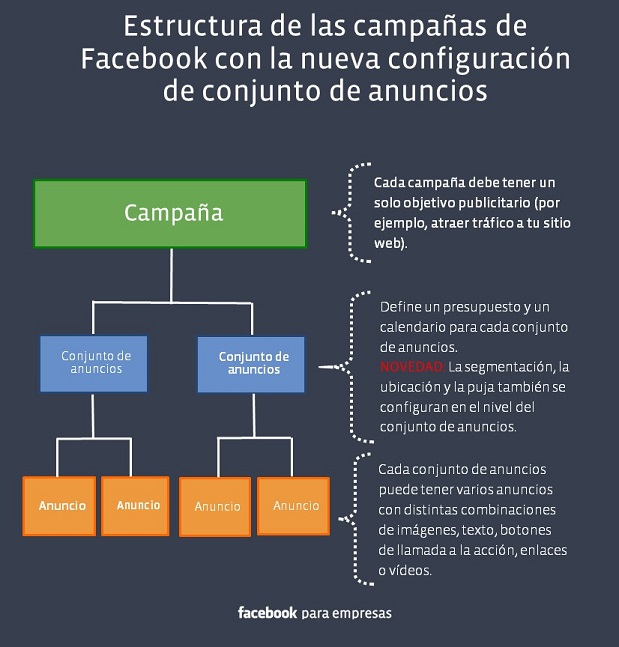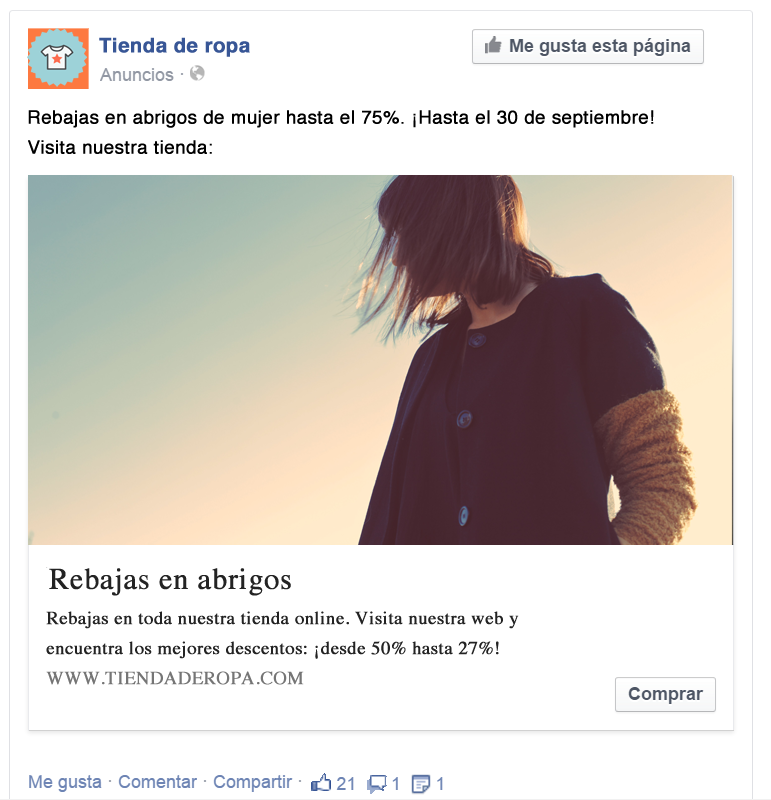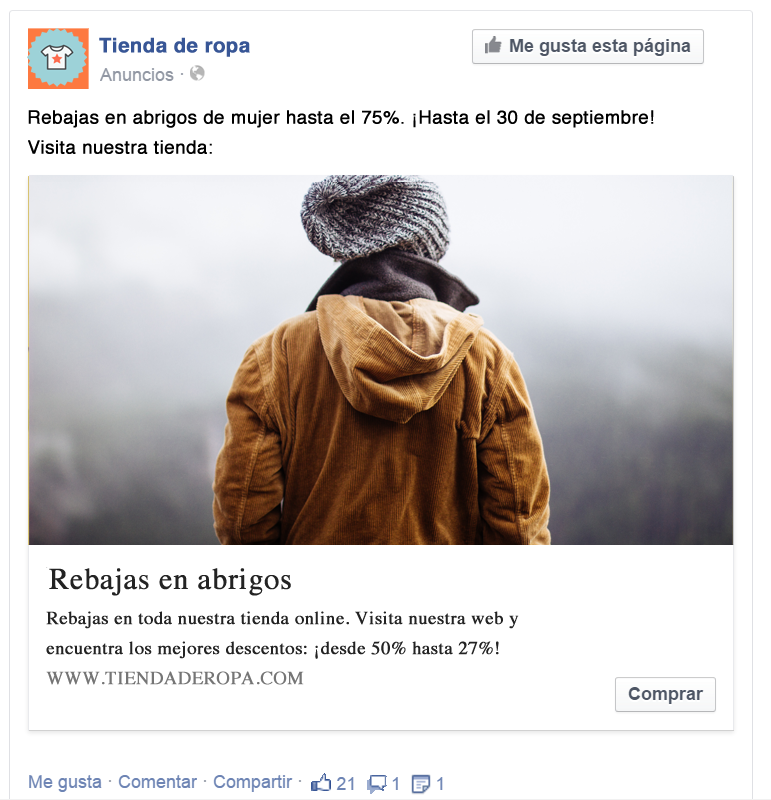Written by María Santoja
Index
- Campaign structure by Facebook Ads levels
- Types of campaigns available on Facebook Ads
- Promote your publications:
- Promote your page:
- Attract people to your website:
- Increase conversions on your website:
- Increase your application installations:
- Increase interaction in your application:
- Reach people who are close to your business:
- Increase the number of attendees to your event:
- Get people to apply for your offer:
- Increase video views:
At the beginning of 2014 Facebook changed the way campaigns were set up to present us with its current organization. It is worth stopping to understand how this structuring works in order to shape campaigns appropriately and get the most out of the available budget. On the other hand, the platform allows you to configure several types of campaigns with different characteristics depending on what we want to achieve with our ads.
In this post we are going to explain in detail how the three-level campaign structure works and which are the 10 types of campaigns by objectives that you can launch with Facebook Ads.
Campaign structure by Facebook Ads levels
Facebook campaigns are hierarchized in three levels of configuration, which allows, on the one hand, to organize the different ads in an orderly fashion, and on the other hand, to carry out comparative tests to discover which configuration is most appropriate.
- Campaign: a Facebook Ads campaign has the same advertising objective that will be defined by the type of campaign we have chosen and we will see in detail below (getting “Likes” on our page, conversions on the website, etc.).
- Ad group: at this level, ads are grouped and an ad layout is designated on the platform, they are assigned a budget, a publication schedule and a segmented audience. That is, the audience, location and bidding are determined.
- Ad: the ad is the materialization of what the audience will see, i.e. the creative and content (the text, images, videos, links and call-to-action buttons).
The best way to understand these three levels is with a case study. For example, we have an online clothing store that sells men’s and women’s clothing. In this case, in a very simplified way, the structure of the Facebook Ads campaign would be:
- Campaign with the objective of “increasing sales on your website”.
- We would create two ad groups, one segmented for male customers, and one segmented for female customers.
- For each ad group we would create at least two ads. In the ads targeted at women, the message and image would refer to women’s clothing, and would link to this section of the online store, and in the ads belonging to the targeted ad group for men, the ads would be focused on the male audience and would link to the men’s section of the store. In each group we would test at least two ad presentations with minor modifications, for example in the photograph of the clothing item, to see which would work best.
As we can see, this tiered structure allows us to perform A/B tests so that we can fine-tune the campaign to keep the ad groups and ads that convert the most, and thus get a better return on our advertising investment.
Types of campaigns available on Facebook Ads
There are different types of campaigns depending on the objective to be achieved. Defining this objective will be the first step to take when setting up your campaign. Facebook Ads currently provides us with 10 different campaign types:
Promote your publications:

Promote your page:

Attract people to your website:

Increase conversions on your website:
The objective of these ads is to get the user to perform a specific action on our website, i.e. to achieve a conversion. For the ad setup it is necessary to enter the website on which the conversions will be measured. Facebook allows you to choose between different types of conversions: payments, registrations, leads, key page visits, adding products to cart and other website conversions. The platform will generate a conversion pixel that must be inserted on the pages where the user is expected to perform the action, in the header section of the HTML code.
When the campaign has already registered a considerable number of conversions, it is advisable to create an audience segmentation that matches the characteristics of the people who have converted. In other words, we will fine-tune the targeting in order to reach the Facebook audience that has been proven to convert on our website with the ad.
Increase your application installations:
These types of campaigns aim to increase the number of downloads of an app. The appearance of the ad, as in the other typologies, is that of a status update, but when clicked, the user is taken to the app store.
It is advisable to segment this type of campaign for smartphone users ( with Android or iOS system, depending on whether the app is available) and even refine by model to ensure that the person who sees the ad has a phone on which to use the application. We can also choose to display the campaign only on mobile devices, so that we ensure that at the time the user receives the ad, they are browsing with their phone and can download the app.
Increase interaction in your application:
In this type of ads, unlike the previous ones, what is intended is that the user performs a specific action in the app store, such as, for example, leaving a review of the app. In this case the ad link can point to different sections of the store.
For this reason, depending on what we are looking for, we should segment the campaign for people who either already have the application downloaded (if we want ratings) or do not have it (for example, if we are looking for registrations). We must also take into account the same segmentation criteria that we have seen in the previous type of campaign.
Reach people who are close to your business:
This type of campaign is based on the geolocation of the audience. We seek to impact people who are close to the business with our advertisement. Therefore, segmentation is configured by adding the address of the location and choosing a radius of action.
In addition, a “How to get there” button can be added as a call to action. When the user clicks on the button, he/she receives directions to the location.
Increase the number of attendees to your event:
This type of campaign is similar to the “Promote a post” campaign, but instead of giving visibility to status updates, the platform increases the visibility of Event type updates.
In this type of campaign it is very important to segment based on location, taking into account, depending on the magnitude of the event, the maximum distance that a person would travel to attend the event.
Get people to apply for your offer:
As in the previous case, this type of campaign increases the visibility of updates of the Offer type. Therefore, to set up the advertisement we will have previously published an offer on our fan page, with an expiration date and, if we want, with a quantity limit. These types of updates and announcements will have a “Get Offer” button.
For physical businesses it is highly recommended to segment the campaign by location to reach people who are close to our establishment.
Increase video views:
We know the communicative power of videos in advertising. Therefore, this type of campaigns are very interesting to work on the brand image of our company.
When setting up the campaign, you will have to upload the video of the advertisement. It cannot be longer than 45 minutes or weigh more than 1.75 GB (see all the technical specifications of the videos here). Also, remember that the thumbnail image of the video must comply with Facebook’s advertising guidelines.
Finally, it is advisable to activate a call-to-action button. Facebook allows you to choose between: “Buy”, “Book”, “More information”, “Register”, “Download” and “See more”.
In short, knowing the structure of Facebook Ads campaigns will allow us to improve our budget control and improve our campaign by checking, for each of the levels, which options convert more. On the other hand, we must keep in mind that the types of Facebook Ads campaigns are based on the objective to be achieved, which should remind us that the strategy should always be above the tool. Knowing the different types of ads offered by the platform will allow us to choose the one that best aligns with our business objectives.









